Now that we were in Tupiza after our long walk, we needed to figure out how to get out of Tupiza to see some of Bolivia’s amazing landscapes. Tupiza is the jumping off point for tours to the far southwest of the country to see the world’s largest salt flat, mountain moonscape, and colorful lakes.
We signed up for a tour with the promise of the tour company that they could get the jeeps out of town regardless of the roadblock situation. So on the morning of May 10th, we piled into the jeep to start our 4 day tour. However, after 10 minutes on an old dirt road, we ran into a new blockade, and this was the last way to get out of Tupiza. So back to the hotel to wait out the strike for another day. The peace talks were underway, but we had no news of when the roads might open up. Mike and I were concerned that we were going to spend our whole month in Bolivia fighting roadblocks, so we made a list of options to get out of Bolivia earlier, including making the long walk back to Argentina!
The next morning, we got ready to go not knowing if we would get out of town or if we would prepare for our walk back to Argentina. Luckily, a compromise had been made, and we passed the blockades! We shared our jeep with another couple, Jens from Germany and Doris from Switzerland, and it was great to become friends with them.
Our tour started with a long, steep ascent out of town with amazing views of the sandstone mountains formed by rain and wind. The views down the valley were awesome, and the reds were so brilliant. As we continued our drive, we went through llama grazing country and a few tiny villages. The houses in the villages were made of mud bricks with a straw/mud roof. We also saw wild llama, vicunas, which are much smaller, and their fur is less shaggy. The domestic llamas were decorated with earrings which made them even funnier looking!
                                                         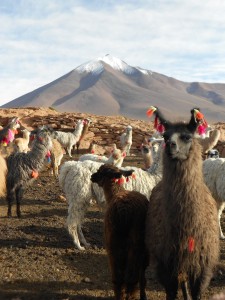   Â
  Â
By afternoon, we had reached 4800m and had amazing views of snow capped mountains in the distance. The main highlight was the abandoned village of San Antonio with Volcan Uturuncu (6008m) towering in the background. The buildings were made of stone, and it was fun to figure out what each of the buildings were used for once upon a time.
                                             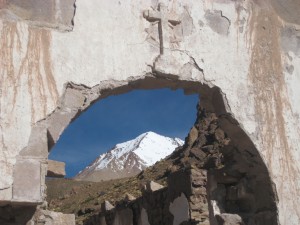                        Â
                       Â
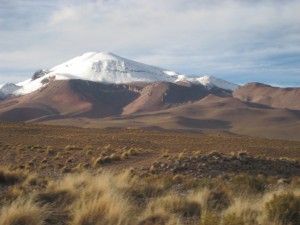 We spent the night in Quetena Chico at 5000 m. It was so high that rolling over in bed made my heart beat faster! Mike and I were both sick with colds, so it was an early night to bed after listening to the local village children sing.
We spent the night in Quetena Chico at 5000 m. It was so high that rolling over in bed made my heart beat faster! Mike and I were both sick with colds, so it was an early night to bed after listening to the local village children sing.
Day 2 was the colorful lakes day! The landscape changed from tufts of grass to bare rock and sand. The landscape made me think that we were on the moon. We were within 25 km of Chile. Laguna Verde is an aquamarine lake with Volcan Licancabur (5930m) in the background. The lake’s color comes from minerals that are carried by the wind. Doris and Jens taught us how to make jumping pictures, so we had fun trying to get the timing right and not get too out of breath!Â
 Â Â Â Â Â Â
     Â
After lunch, Mike enjoyed the natural hot springs looking over the small salt plain of Salar de Chalviri. I didn’t want to get wet since I was sick, but it sure seemed relaxing. There were also a few mud pools and fumaroles to check out.
The real highlight of the day was Laguna Colorado, a bright adobe-red lake with flamingos. The red color is due to algae, and there were also small islands of white due to the formation of borax. The flamingos prefer this lake to many of the others in this area because it is the warmest in temperature. There were many baby flamingos, which were white and brown colored, in this lake too. It was so beautiful, but really, really cold too!
                                            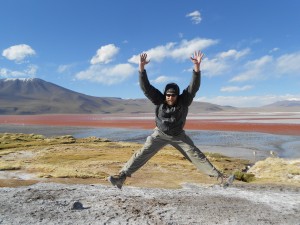
The third day of our tour continued with barren landscapes with little vegetation. There were some really interesting rock formations that were carved out by the high winds. They made for fun pictures!
We also stopped at several lakes to take pictures of the beautiful scenery. The lakes were packed with flamingos. They are so graceful, and it is really neat to watch them take off and land as their skinny legs skim the water. It was also fun to watch them use their beaks to hoe and scoop up food. Their beaks are big!
Our lunch stop had a magnificent view of Volcan Ollague which is an active volcano. We could see steam rising from its ridge line, and it reminded me of Mt. St. Helens, but on a much bigger scale! The volcano is right on the border of Chile.
In the afternoon, we crossed Salar de Chiguana, which is a small salt plain that was originally part of the same pre-historic salt lake as Salar de Uyuni. It was so windy that we couldn’t see anything, so it was a low-key afternoon.
Our hotel was right on the edge of the Salar de Uyuni and was actually made of salt. The floors were large salt grains, the walls were covered in salt, and even the light fixtures were decorated in salt! In the evening, we enjoyed talking to the occupants of the other jeep that was traveling with us, including Tina from Sydney, Claire from Switzerland, and Eric and Delphine from France. We played global Uno incorporating many different house rules, and it got to be rowdy and really fun.
 Salar de Uyuni was the highlight of our last day on the tour, and I am glad that it was last because it was incredible! The salt flat is the largest in the world and occupies 12,000 square kilometers. The salt is 130 m deep with a salt lake underneath. In every direction all you see is white with rocky mountains as the backdrop.
To get the most out of the day, we woke up early to watch the sunrise over the salt plain. It was a gorgeous sunrise of pink, purple, orange and yellow. Mike and I practiced a little yoga to help us keep warm while taking in the beautiful scene.
Once the sun was up, it was time to take funny photos. Since there is just flat white for as far as you can see, it is possible to make tricky photos. It was a blast with the whole group setting up and taking the pictures. Doris and Jens were super creative, and it was fun to get everyone involved in group photos! It was hard work setting up the shots, especially at 3600m!
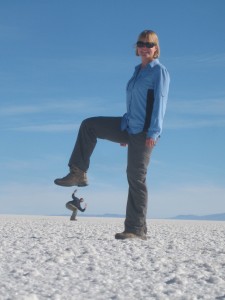 Â After our photo session, we drove across the flats. The salt forms hexagonal shapes, which helps add some dimension. As the sun rose higher, the whiter and more brilliant the salt became resulting in the background mountains seeming to float off the ground. It was pretty awesome.
 After our photo session, we drove across the flats. The salt forms hexagonal shapes, which helps add some dimension. As the sun rose higher, the whiter and more brilliant the salt became resulting in the background mountains seeming to float off the ground. It was pretty awesome.
We arrived in Uyuni in the afternoon to discover all the roadblocks were finished, so we could now continue our exploration of Bolivia! It was an amazing four days with breathtaking scenery everyday and new friendships from around the world.Â


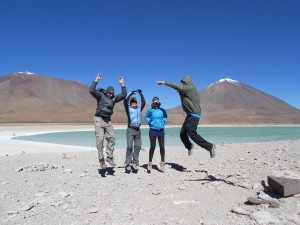
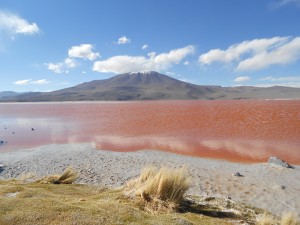
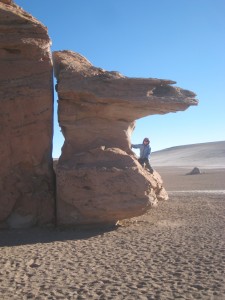
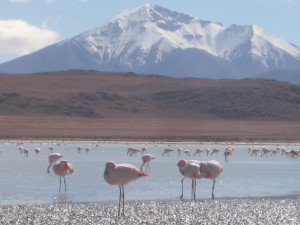
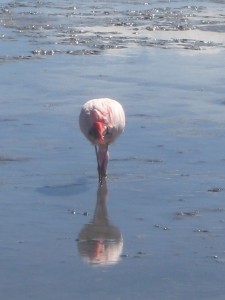

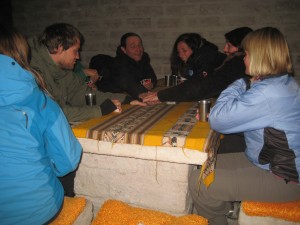
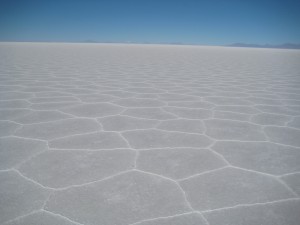

This was a great post… It sounds like a magical place, and one that few experience. What an adventure, and glad the road blocks were gone when you returned. I loved the trick photos, without perspective you can do some cool things. The final one of you yogaing was super.